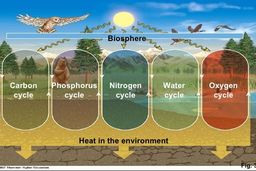image from activeagriculture.com
option C.6: (AHL) Nitrogen and phosphorus cycles

Essential idea:
- Soil cycles are subject to disruption.
Nature of science:
- Assessing risks and benefits of scientific research—agricultural practices can disrupt the phosphorus cycle. (4.8)
Understandings
C 6.1 U Nitrogen-fixing bacteria convert atmospheric nitrogen to ammonia.
C 6.2 U Rhizobium associates with roots in a mutualistic relationship
C 6.3 U In the absence of oxygen denitrifying bacteria reduce nitrate in the soil
C 6.4 U Phosphorus can be added to the phosphorus cycle by application of fertilizer or removed by the harvesting of agricultural crops
C 6.4 U The rate of turnover in the phosphorus cycle is much lower than the nitrogen cycle.
C 6.5 U Availability of phosphate may become limiting to agriculture in the future
C 6.6 U Leaching of mineral nutrients from agricultural land into rivers causes eutrophication and leads to increased biochemical oxygen demand
Application
C 6.1 A The impact of waterlogging on the nitrogen cycle
C 6.1 A Insectivorous plants as an adaptation for low nitrogen
Skills
C 6.1 S Drawing and labelling a diagram of the nitrogen cycle
C 6.2 S Assess the nutrient content of a soil sample
Key Terms
Classroom Assignments:
Useful Links
In the News
Video Clips
